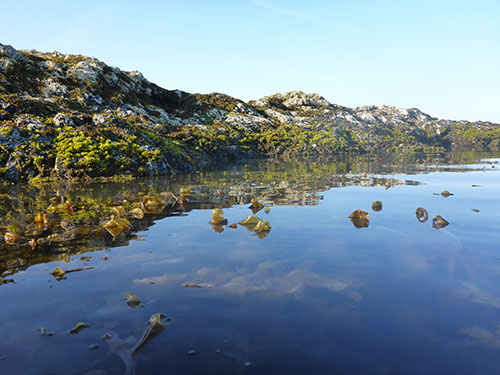
Formation of Kelp and Marsh Grass Detritus as Potential Shellfish Nutrition
Project Description
Most models assume bivalve shellfish to be the equivalent of “aquatic cows,” grazing almost exclusively on standing stocks of phytoplankton and algae. Cultured bivalve species have an exceptional capacity to filter large volumes of water containing not only phytoplankton, but also zooplankton, detritus, and other suspended particulate matter (Ferriera et al., 2008). In Ireland, it has been estimated that shellfish remove four times more detritus than phytoplankton (Ferriera et al., 2007). Byron et al. (2011) found that in a highly productive temperate bay (Narragansett Bay, R.I.), 71 % of the total energy flow of the ecosystem originated from detritus, and that large quantities of shellfish aquaculture could be supported sustainably with incremental decreases in the large detrital pool. In order to identify optimal site placement of farms in areas of high nutritional quality for shellfish, researchers must consider the role of detritus. Specifically, at what rate do different primary producers generate new detrital material suitable for shellfish ingestion?
In the laboratory, project personnel are decomposing kelp organic matter to quantify how stable isotope and lipid biomarkers change through decomposition. Researchers hope to calculate a decay rate for detritus and learn more about its nutritional quality. Stable isotopes and fatty acids are used to track detritus, and this project researches how those values change as plants decompose to form detritus. The study will also compare sources of organic matter that fuel food webs at a mussel farm and nearby wild mussel beds.
Secondary production of coastal food webs is often estimated from phytoplankton production. The importance of other sources of primary production and organic matter in promoting secondary production is often underestimated. Macrophyte-derived organic carbon contributes to temperate near-shore benthic secondary production (Mann, 2000). Organic carbon derived from kelp (Laminariales) contributes to growth rates of benthic suspension feeders (Duggins et al., 1989).
Quantifying energy sources and flow through a food web allows for more accurate carrying capacity estimates for bivalve aquaculture and site placements. This information will be useful for tracking detritus through ecosystem food webs and identifying it in the field. It will also potentially change the way farmers use detritus in aquaculture and advance SEANET’s mission as a whole.
Results and Accomplishments
Aquaculture farms are becoming an integral part of the coastal marine ecosystem and associated food webs. Bivalve shellfish grown on farms filter feed on suspended particles and contribute biodeposits that are recycled back into the food web. The suspended particles are comprised of organic matter, some of which are in a degraded form. The stable isotope analysis of laboratory – degraded kelp shows that the isotopic composition changes with degradation. There is now a catalog of stable isotope signatures of organic matter in both living and degraded forms. Therefore, researchers can better track nutritional sources of farmed bivalves.
This information will help researchers better understand how coastal food webs support shellfish farm production. For example, personnel found higher biodiversity of small macrofauna and macroalgae species at mussel farm sites compared to analogous and nearby dock sites. The food web structure, as determined by Layman metrics, is fairly consistent across both dock and farm sites. This work provides contextual and supporting information for related projects on detritus and shellfish nutrition.
Summary of Data Being Collected
| Data | Type | Quantity | Location |
| Lipid and stable isotope analysis | Alaria macroalgae as it degrades into detritus | Samples taken bi-weekly | Alaria grown in UNE Marine Science Center |
| Stable isotope C & N data | Particulate Organic Matter (POM), phytoplankton, zooplankton, assorted invertebrates, and fish located near shellfish farms | Collected once per summer | 1-2 locations in Saco Bay and Casco Bay |

